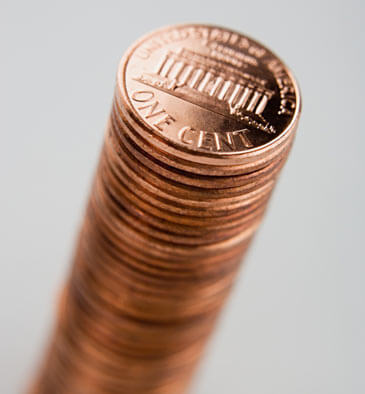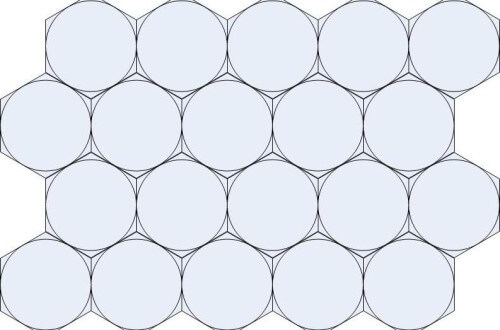Ricochet is the best place on the internet to discuss the issues of the day, either through commenting on posts or writing your own for our active and dynamic community in a fully moderated environment. In addition, the Ricochet Audio Network offers over 50 original podcasts with new episodes released every day.
 Weekend Geek: Pennies to Heaven
Weekend Geek: Pennies to Heaven

In case you need to get your mind off the Supreme Court, here’s a fun math problem for the weekend. Imagine a stack of pennies from the surface of the earth to the surface of the moon (equator-to-equator; neglect rotation of both bodies and all other factors that would make this impossible). Use the properties of modern (post-1982) pennies. The distance from the earth to the moon varies a lot, so use the mean (or “semi-major axis”) distance. You may have seen this problem before, but I’m taking it a little further:
1. How many pennies would be required to reach from the earth to the moon?
2. Do that many pennies exist?
3. What’s the mass of all those pennies? What do they weigh on the surface of the earth (not stacked)?
4. What do they weigh on the surface of the moon (not stacked)?
5. It’s often said that if you want to create the impression of a large quantity of something, talk about how long it would be if you stacked those things end-to-end. But if you want to create the opposite impression, talk about how much volume they would occupy stuffed into a box. If all those pennies from the earth to the moon could be packed into a perfectly cubical box, what would be the size of the smallest possible box that could hold them all?
6. Neglecting rotation, if all the pennies were in a single stack, and placed on a scale on the earth (not going to the moon, just out into space), what would the scale read?
7. Similarly, if all the pennies were in a single stack, and placed on a scale on the moon (again into space), what would the scale read?
8. Again neglecting rotation, if the pennies were stacked from the earth to the moon, what would the earth scale read? What would the moon scale read?
9. Still neglecting rotation, is there a limit to what a stack of pennies might weigh on earth, assuming the stack goes on forever? What about on the Moon?
10. Assuming the earth rotates, is there a maximum height of a stack of pennies? (Neglect wind resistance, column slenderness, compressive stresses, and all the other factors that make the stack impossible from a practical standpoint.) What’s the mass of the stack, and what would it weigh on the scale?
11. How strong is the gravitational attraction to the moon of objects on the earth’s surface? How does such a weak attraction cause the tides?
The answers may surprise you. Feel free to guess if you don’t feel like doing the math.
(Answers: 1. As many pennies as the Supreme Court finds are necessary. 2. The pennies exist regardless of the original intent of the Mint. Okay, I guess I need to get my mind off the Supreme Court too. The real answers will be posted on Sunday, unless Ricochet nails them all before then.)
ANSWERS:
1. Approximately 247,554,450,000 (See comment #41).
2. Over 302 billion pennies have been minted between 1983 and 2014. Over 80% of them would be required to reach the Moon, if that many are still in existence (not flattened and embossed as souvenirs, for example). See comment #42.
3. Mass 618,886,000 kg (1,364,387,000 lb). Weight 6,069,416,000 N (1,364,387,000 lb). See comment #43.
4. Weight on the moon 1,003,833,000 N (225,658,850 lb). See comment #44.
5. Cube is 49.08m (161 ft) on a side (see comment #45).
6. Approximately 101,070,700 N (22,720,400 lb), just 1.67% of what they would weigh flat on Earth’s surface (see comment #46).
7. Approximately 4,619,000 N (1,038,300 lb), just 0.46% of what they would weigh flat on the Moon’s surface.
8. Earth scale 100,700,450 N (22,637,200 lb), just 1.66% of what they would weigh flat on Earth’s surface. Moon scale 4,248,800 N (955,100 lb), just 0.42% of what they would weigh flat on the Moon’s surface.
9. The Earth limit is about 102,783,900 N (23,105,500 lb). The moon limit is 4,640,300 N (1,043,100 lb). Note that even though the Moon has 1/6 Earth gravity, the limit on the Moon is about 1/22 of the Earth limit. Due to the Moon’s smaller radius, its gravity field diminishes more quickly than that of the Earth.
10. If the Earth rotates, all pennies have an angular velocity equal to one revolution per day. The centripetal acceleration increases with increasing distance from the Earth while the gravitational acceleration decreases. They are equal at a radius of 42,240,500 m, which is about 22,300 miles above the surface of the Earth (the same altitude of geosynchronous satellites). This requires about 23,593,693,000 pennies with a total mass of 58,984,200 kg and weight of 82,653,600 N on the earth scale (14.29% of what the pennies would weigh flat on Earth).
11. Objects on Earth’s surface are subject to a gravitational attraction of approximately 0.0000329 m/s^2 (about 0.00000335 g), with the moon at its semi-major axis distance. Although this gravity field is quite weak, it is able to produce tides acting on a very large mass of water such as an ocean. No noticeable tides are produced in smaller bodies such as lakes. The largest tide observed in the Great Lakes produces a difference in water level of approximately two inches.
I have not posted the equations for questions 7 -11 in the comments. I can do it tomorrow if anyone is interested.
Published in General





My calculator only add, subtracts, multiplies and divides. By choice. Oh, I can figure out how many pennies fit in 240k miles; I do arithmetic all day, every day. Math is something else. By the same token, I have a flip phone.
After the last couple of days, I would not put it past them. Although I would love to read Scalia’s dissent to that one.
A penny is the one with Lincoln on it, right?
No, that’s a one cent coin. The penny has the Queen.
Another Canuckistani has outed himself!
No, the literal name of the coin with Lincoln is the cent. It is only colloquially called “the penny.” The penny is a British coin. I’m not sure whether Canadians have pence or cents without looking it up. I’ll get back to you.
Nope. Canadians have cents, not pence. So, perhaps only Britain and some other pound-based currencies have pence.
So we’re not building a pence. Makes cents.
And certainly not on the border, because those people are just committing acts of love.
They come here because we peso much more.
ANSWERS:
1. The semi-major axis distance from the Earth to the Moon is 384,399,000 meters (238,854 miles). However this is the distance from center to center of the two bodies. We need the distance from surface to surface, so we subtract the radii of the two bodies. I assume the pennies will be stacked at the Earth’s equator and will extend to the equator of the Moon.
Equatorial radius of the Earth: 6,738,100 m (3963.17 mi).
Equatorial radius of the Moon: 1,738,140 m (1080.03 mi).
Subtracting, the surface to surface distance from the Earth to the Moon is:
384,399,000-6,738,100-1,738,140 = 376,282,760 m (233811 mi).
Thickness of one penny: 1.52 mm.
Number of pennies required: 1000mm/m x 376,282,760m / 1.52mm = 247,554,450,000 pennies (rounding off excessive significant figures).
2. Probably.
Mintage varies widely by year from 1983 to the present, but averages around 9.7 billion per year (302,757,989,317 from 1983-2014). The above number of pennies would require more than 80% of the pennies minted since 1983, assuming they are all still in existence.
The reason post-1982 pennies were specified was to ensure that they would all be the same weight. Pennies minted prior to 1983 had a different composition of metals, and were heavier.
3. Mass of one penny = 2.5g (1983 to present; earlier pennies were heavier).
Total mass of all the pennies:
247,554,450,000 x 2.5g /1000g/kg = 618,886,000 kg (1,364,387,000 lb).
Total weight on Earth:
Earth gravitational acceleration: 9.807 m/s^2
Earth weight = 618,886,000 kg (9.807 m/s^2) = 6,069,416,000 N (1,364,387,000 lb).
4. Moon gravitational acceleration: 1.622 m/s^2
Total weight of pennies on the Moon:
Moon weight = 618,886,000 kg (1.622 m/s^2) = 1,003,833,000 N (225,658,850 lb).
5. The minimum volume for the pennies will be achieved when the pennies are packed in neat stacks in a hexagonal pattern, like this:
Each penny therefore occupies the same amount of space as the smallest hexagon it can fit inside. The packing factor will be the ratio of the area of one penny to the area of the hexagon.
So the packing factor is 0.9069. This means that of the volume in the box, 90.69% will be pennies, and 9.31% will be wasted space. The edges can be neglected since the box is going to be huge compared to the size of a penny.
6. Newton’s equation of gravitation:
This equation is to be integrated from the surface of the earth to the endpoint in space.
just 1.67% of what they would weigh laid flat on Earth’s surface.
As I said, requires calculus. Not a big deal, I was just being too lazy. ;^D
My understanding is that congress is considering eliminating pennies from the U.S. coin pool: leave it to politicians to find new ways to make us penniless.
Considering the penny of 1912 was worth about what our quarter is today, that means are penny ain’t worth a split farthing.
I want to see a graph of the function that relates visible turtles to pennies climbed.